ALL ABOUT RUBY

What’s a ruby?
A ruby is a rare and precious gemstone, valued by humans for thousands of years and esteemed as the ‘King of Gems’. Gemmologically, rubies are the red form of the mineral corundum which is generally known as sapphire, with chemical composition Al2O3 with traces of chromium (red) & sometimes iron and vanadium. With a hardness of 9 on the Mohs scale, corundum and therefore ruby, is one of the world’s hardest minerals making it tough and durable in wear, and an excellent choice for frequent wear, like engagement rings.
Why are rubies called rubies?
The name comes from the Latin for red, ‘ruber’.
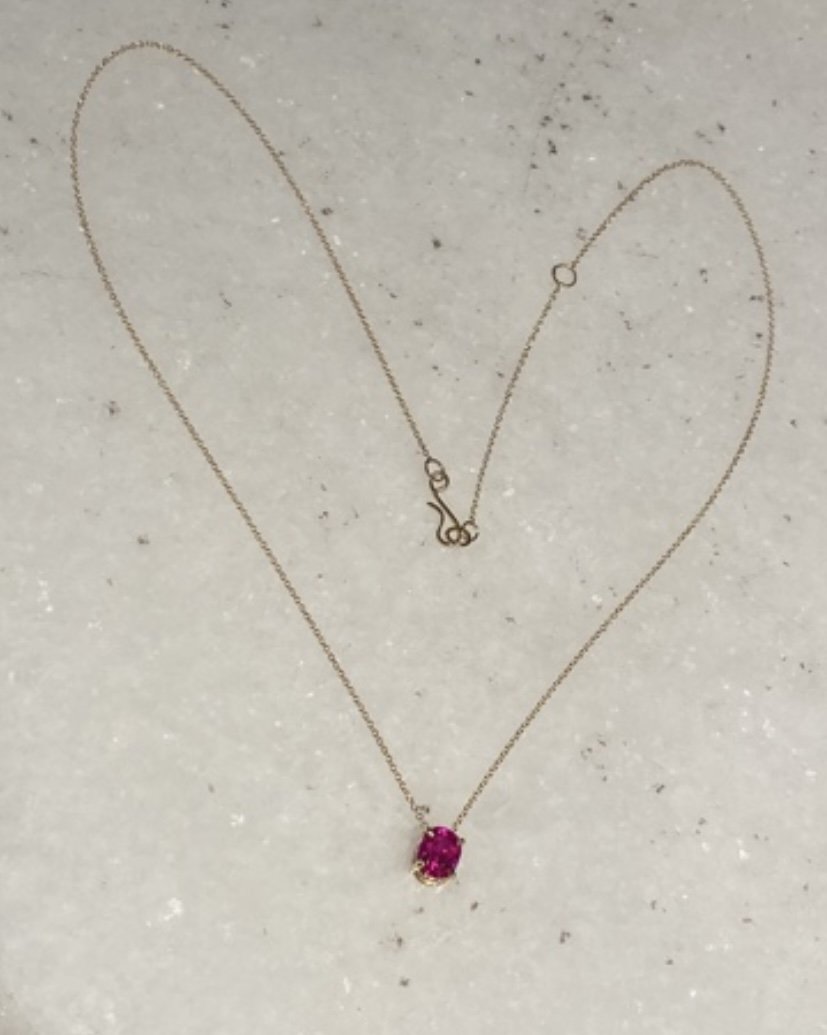
Love now and forty-ever - a bespoke Burmese ruby 1.25ct pendant 40th anniversary gift
How many years is a ruby anniversary?
Ruby is the gem for the 40th anniversary. I like to remember it by thinking, if life begins at 40, why not great passion too, and ruby is the traditional gem for intense romantic love. I’ve made two fabulous ruby anniversary gifts recently, both of which were top secret and very romantic as the wives hadn’t a clue what was being made for each of them. Well, almost – one of the wives is a forensic accountant and despite her husband’s attempt to send me the final payment upon completion for his creation, he must have somehow left a tell-tale clue, because she came into his study waving a statement asking, ‘What’s this??!’ And he had to confess his subterfuge, but happily to an overjoyed and very moved wife!
What’s the origin of the Ruby Anniversary?
Despite the romance of the occasion, I have to admit that almost all wedding anniversaries in units of 5 years were invented by the American jewellery trade around 1937 to boost gift giving, which has since spread in popularity to most of the other consumer jewellery markets. However, the practise of celebrating jubilees and wedding anniversaries with precious metals dates back to the Roman practise of celebrating 25 with silver and 50 years with gold. The custom was also celebrated by a ‘jubilee’ marking the length of a monarch’s rule in the west notably for Queen Victoria’s 25th and 50th and even a special Diamond 60th Jubilee.
What month is ruby birthstone for?
Ruby is the birthstone for July. It’s easy to remember it like the luscious ripe strawberries during July’s Wimbledon tournament, not to mention everyone’s favourite summer party drink, Pimm’s. Rubies are rare and costly, and regarded throughout history as fit for kings and the stone of passionate love. They are the perfect match for those born in July - smoulderingly passionate Cancers and fiery regal Leos. Another reason that rubies are perfect for July born Westerners is that many rubies (except Thai/Cambodian gems) have enough chromium in their chemical composition to fluoresce in the summer sunlight… just look at this ring I sold recently, for example: (A lovely Burmese ruby ring fluorescing in the sunlight)
What’s the most special ruby jewel?
To my mind the late Queen Elizabeth II’s Ruby Rose tiara, designed and created in 1973, is one of the most deeply symbolic jewels I know about personally. It was created by Garrard, where I spent 5 years as a director. The tiara was created using 96 beautiful Burmese rubies originally given by the British ruled nation of Burma to Her Majesty in 1947 as a necklace – the number 96 was chosen because the Burmese believe there are a total of 96 ‘harms’ that can befall you, but that a ruby will provide total invincibility to its wearer. So it was a strange coincidence that Her Majesty sadly died at the great age of 96.
What is the most expensive ruby ever?
The world record for a ruby is a ring sold at Sotheby’s Geneva auction in May 2015 for $32.42 million and unsurpassed since then. David Bennett, the former worldwide Chairman of Sotheby’s Jewellery Department, who handled the sale on behalf of its private owner, said that when he first saw it, it literally took his breath away and is the most extraordinary and magical gemstone he’d seen in 40 years. David named gem the Sunrise Ruby after a poem by his favourite poet Rumi, the 16th century mystic. The ruby was set into an elegant classic Cartier ring, flanked by a pair of fancy-cut half-moon shaped diamonds. The incomparably beautiful ruby was a whopping 25.59 carats in size – this is beyond enormous for ruby. Not only was it huge, but it was cut into a perfectly proportioned cushion-oval shape and was an intensely rich red, evenly saturated, with very good clarity. It was also entirely as nature had made it, without further heat treatment.
What is the history of rubies?
Rubies picked up the river gravels of S E Asia were the first sources of early jewel collections. In around 600 AD, historians have traced gem mining in Myanmar (formally Burma). Ancient and Moghul Indians revered rubies, calling them ‘ratnaraj’ – the king of gems. Wealthy Romans also sought them out, and gave them the name ‘ruber’ meaning red, and subsequently we know them in English as ruby. The Venetian adventurer, Marco Polo, observed gem mining in Sri Lanka in 1292, including for rubies, and he wrote that the beautiful island was blessed with streams full of them and many other gems. Responding to the increasing demand of courtly European clients in an increasingly wealthy Western world, the French gem merchant, Jean-Baptist Tavernier (1605-1689) recounts that he had to bargain the hardest to prise rubies from their Indian owners, often sourcing direct from royal treasuries.
In Medieval Europe, rubies symbolised the Passion of Christ and physical love, and craftsmen often set them into heart shaped mounts whereas blue sapphires, instead of rubies, symbolised spiritual love - the idealised ‘true love’ that transcends the corporal realm.
Why are rubies red?
Tiny amounts of chromium cause ruby’s red colour. Without it, we’d have a transparent corundum. Ruby is all about the chromium. When a tiny amount of chromium, a very rare earth metal, is present in the host rock, it replaces some of the aluminium atoms (1%) in the crystal structure and this makes the resulting light returning to our eyes red. Sometimes iron is also present, as well as vanadium, and this alters the colour.
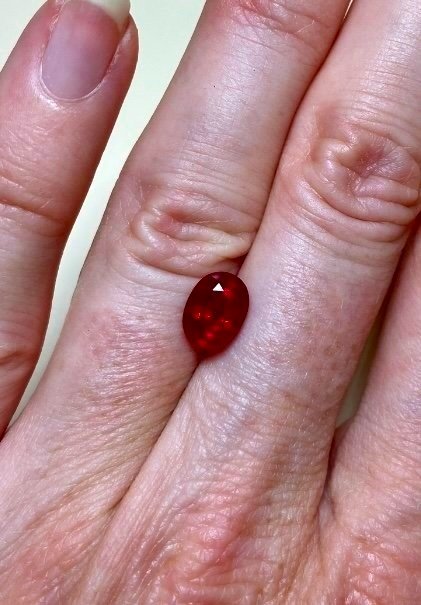
A fine no-heat ‘pigeon’s-blood’ Burmese ruby which I recently sourced for a client
What is a ‘pigeon’s-blood’ ruby?
The most coveted colour is a bright and pure red of intense saturation like a laser light. These vivid, well coloured gems are often labelled with the traditional but rather fanciful and vague term coined long ago by the jewellery trade ‘pigeon-blood red’. Most rubies often show a secondary colour giving a pinky or purply colour – iron gives a ruby a darker purply colour, and these tints and hues are less desirable.
What’s Nature’s surprising recipe for fine Burmese ‘pigeon’s-blood’ ruby?
The intense red of fine Burmese rubies is caused by the salts and organic matter which evaporated on the dried-out surface of the area of limestone that became the host rock for the gems, before it was cooked up into marble by the millions of years of heat and pressure caused by India’s tectonic collision with Asia. Some of the ‘organic matter’ responsible for Nature’s top ‘pigeon-blood’ ruby recipe is the poo of unicellular organisms, so as I like to say, rubies happen.
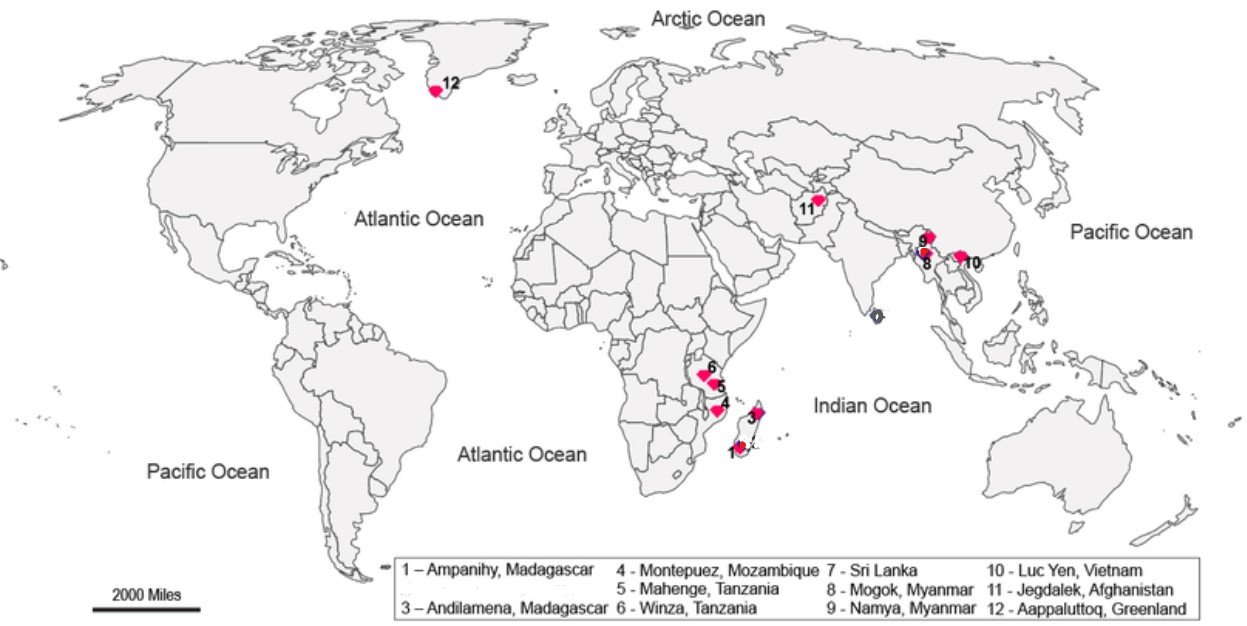
Map of major ruby mines of the world (adapted) Creative Commons
Where do rubies come from?
The source of the most legendary rubies in the world is the area around Mogok in Myanmar (Burma), about a day’s car journey north-east from Mandalay. These are the so-called Burmese rubies, and the finest examples of these are the benchmark against which all good rubies are judged for colour and clarity.
Mogok also enjoys a treasure of other gems, including fine sapphire, spinel, tourmaline, peridot, topaz and moonstone. In Myanmar, rubies are found in mines dug into the mountains that follow the veins of ruby bearing marble. Centuries ago, rubies were more easily found in the mountain streams where erosion had washed the gems over millions of years.
Rubies are also currently found in Mozambique in relatively sizeable quantities for the jewellery trade. Fine quality rubies are also found in lower quantities in other nations: Thailand, Cambodia, Vietnam, Madagascar, and most recently in Aappaluttoq, Greenland.
ENJOYING READING THIS ARTICLE?
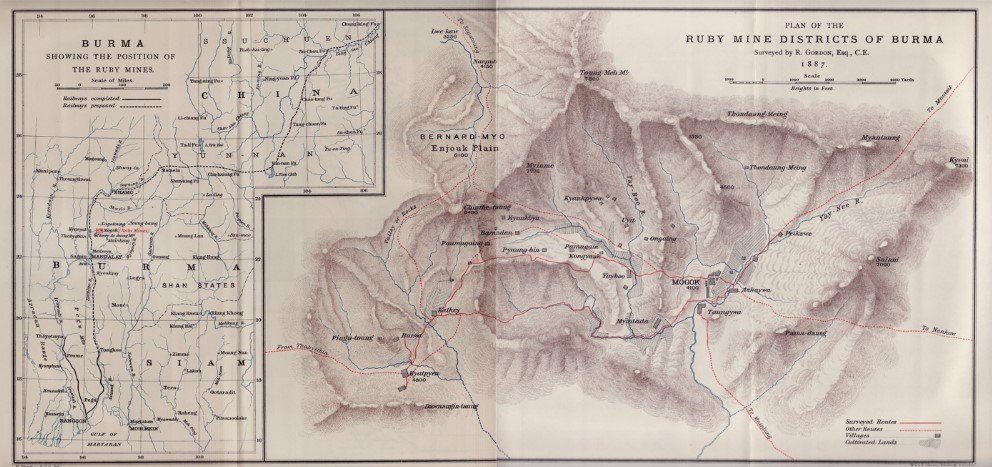
The Mogok ruby mining region, Myanmar, map after Gordon 1888.
What’s the history of ruby mining?
All gem mining is arduous and unpredictable. Because of the low return on investment, most mining is done by hand by small groups of miners, either formed from family groups or local co-operatives. Using mechanical methods is often impractical in mountainous, remote and heavily forested terrain, drenched by monsoons.
We can trace humanity’s love of fine rubies back to 2,500 years from mining activity in Sri Lanka, and even further back to 5,000 years by stone tools discovered in Myanmar. Some gem experts date mining activity in Myanmar to AD 600, but the earliest records of mining there record a law enacted by the King of Burma regulating all mining activities and demanded that larger stones be surrendered to him. Britain led an armed expedition to the Mogok mining region in 1888 during its colonisation of the country, and set up a camp, which in time became a commercial ruby mining business that operated intermittently until the mines were considered too depleted for mechanical extraction in the early 20th century. Since Burma’s independence from Britain in 1948, the mines have been mined by Government approved small-scale mechanical mining co-operatives and artisanal miners.
Since this heyday, modest volumes of rubies mostly mined from Thailand, Cambodia and Vietnam fed market demand. So, it was a tremendous boost for jewellers when from around 2010 the company GemFields started mining and marketing African rubies sourced from the important new deposit of Montepuez in Mozambique, where ancient rivers ground away the original mountains containing the rubies over hundreds of millions of years, leaving a layer of ruby gravel just under the soils, now revealed by earthmoving mechanical diggers.
Famous people and famous rubies

Liz Taylor wears her stunning ring created by Van Cleef & Arpels, photo Eve Arnold
Think of jewellery and famous stars, and you automatically think of Elizabeth Taylor, and in her stunning collection was a ruby ring with a typically romantic story. Taylor’s ruby ring was given to her by husband Richard Burton who determined to buy her the most perfect ruby he could find. Ruby was his favourite stone - red for Wales, his national colour. After searching for four years, he found a 8.24-carat oval unheated Burmese ruby set in a classic cluster ring from Van Cleef and Arpels, and tucked it into her Christmas stocking for her to open on Christmas day at their Alpine chalet in Gstaadt, December 1968.
Taylor wrote in her memoirs, Elizabeth Taylor: My Love Affair with Jewelry, that “I opened the box very, very slowly. Inside it glowed with the fire of the most perfect colored stone I’d ever seen. With the most perfect cut. I’m sure I almost fainted. I screamed, which probably echoed over the mountains, and I couldn’t stop screaming. I knew I was staring at the most exquisite ruby anyone had ever seen.”
What is the most famous ruby ever?
Undoubtedly the most famous of all rubies is the Black Prince’s Ruby. This supersized 170ct unfaceted and irregularly shaped cabochon gem is set into the front of the Imperial State Crown of the British Crown Jewels. It shows the signs of a drill hole and a tantalising glimpse into its previous history as a regal jewel traded across nations and centuries. Many stories have been told about this jewel; none can be proved. The one thing that is known for sure is that it’s not a ruby at all. It’s a red spinel, a valuable gemstone that can be found alongside ruby, but that often occurs in much larger crystals. Its name comes from the Medieval English name for a spinel, ‘balas ruby’, subsequently shortened to ‘ruby’.
Along with the Black Prince’s Ruby is another legendary and equally mysterious ‘ruby’ the Timur Ruby. This is an even larger 361-carat balas ruby, or rather, ruby, and comes with a similarly tangled history of murderous princes and kingdoms but we know rather more about its provenance because it was engraved by five of its princely owners with their names: Jahangir (1569-1627), the 4th Mughal Emperor; Shah Jahan (1592-1666), the 5th Mughal Emperor; Farrukhsiyar (1685-1719), the 10th Mughal Emperor; Nader Shah (1688-1747), Shah of Iran; and Ahmad Shah Durrani (1722-1772), King of Afghanistan. Jahangir also had the name of his father, Akbar the Great, engraved on it. Like the Black Prince’s Ruby, The Timur Ruby is also held in Britain, set into a necklace, and safeguarded personally by Her Majesty Queen Elizabeth II as part of the Royal jewellery collection.
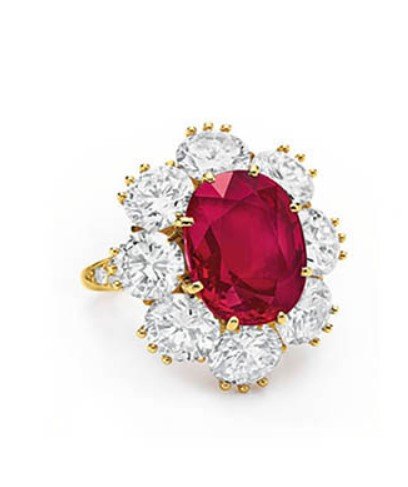
Liz Taylor’s perfect ruby ring took husband Richard Burton 4 years to find, photo Christies'
How to buy a ruby - my 5 Tips
Buying guide
Ruby is next to diamond in terms of gemstone value. Chromium is one of Earth’s most rare elements, and the occurrence of fine ruby formation is so rare it warrants top prices.
Like all gems, use the classic 4 C’s approach of colour, clarity, cut and carat, plus geographic origin & treatment. Colour is top, be prepared to pay for quality and for significant purchases always obtain the seller’s disclosure on treatments and get a gem report from a reputable, specialist gem laboratory and .
- Always look for the best brightest red colour, like a laser light.
- Next important is clarity – and as ruby is typically full of inclusions, the ‘cleaner’ the ruby, the more of a gem it is.
- Of joint consideration is cut and carats (ie weight) – faceted gems are more expensive as they are more marketable than cabochons, unless the stone is a star ruby. The shape of the rough crystal determines what shape the finished cut gem will be – mostly oval, round or cushion shape - and often the rough is quite thin/shallow, hence well-proportioned gems are considered most desirable. Ruby tends to crystalise in small sizes, so any gems over 4-5mm which are 1 – 1.5 carat in weight are rare.
- For geographic origin, a special mystique is attached to gems originating from Myanmar (Burma) so these attract a premium. Any gem with an interesting or historical provenance claims added value.
- Many gems on the market will be heat treated (see section below How to spot treated ruby) and it’s rare for a gem not to have been heated to improve its colour and clarity. If the ruby has not been heated, then a much higher premium is sought!
How to tell if a ruby is real?
A client’s sentimental family ‘ruby’ ring that unfortunately wasn’t actually the real thing! Look at the tell-tale white facet lines on the right.
Rubies can be confused with other real, natural red gems: rubellite (red tourmaline), garnet, spinel, red zircon.
Fakes made of lead coloured glass have been around for over 1,000 years, and millions of carats of lab-made synthetic flame-fusion (Verneuil) rubies created for laser technology and adopted by the horological and jewellery industries, have been around 100 years. Red CZ is a popular simulant too.
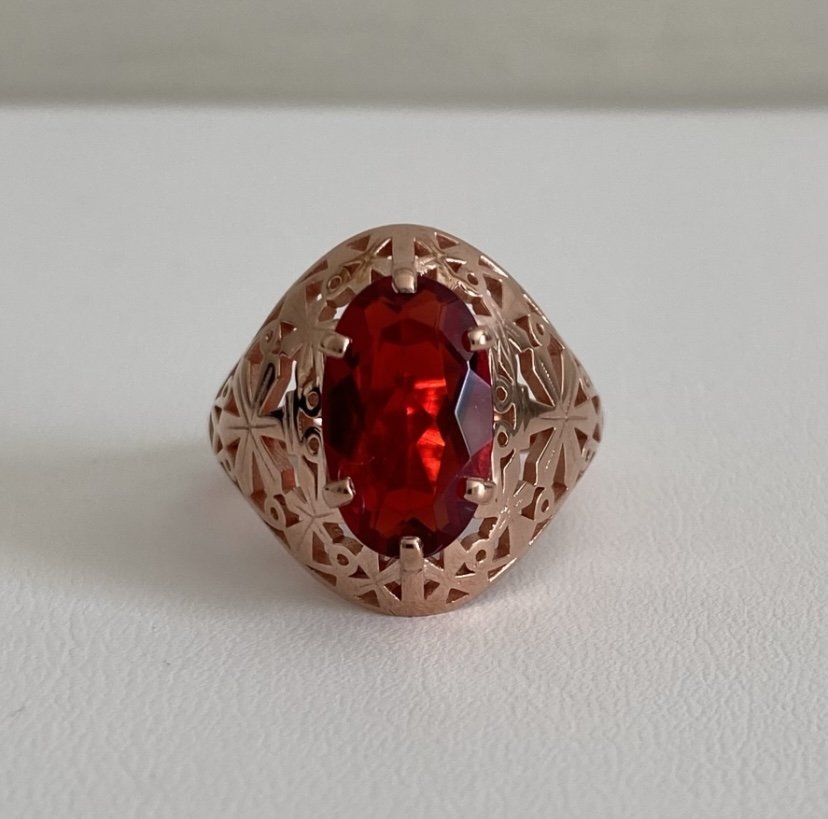
Use your eyes:
- If the gem is an even colour and completely transparent, is a large size, and seems too good to be true, it probably is! Most rubies have quite a lot of inclusions and are quite small.
- Size matters – rubies rarely form in large crystals, and after cutting will lose over half their original rough weight. It’s really rare to see rubies much bigger than 4-5mm in diameter and 1-1.5 carats in weight.
- Look at the facet edges on the ruby. As ruby is second to diamond in mineral hardness, it takes a very good polish and will have super sharp facet edges. Fakes made of softer material like red CZ or glass (paste) have broader facet edges which reflect the light, making them look like white lines.
- In sunlight, does the ruby have a fiery glow? If so, this could be fluorescence which is a trait of many rubies due to their high chromium level.
Take a closer look:
Using a 10x hand lens (jewellers’ loupe) hold the stone close to your eye and shine a strong light through it. Best gems have very good transparency, with only a few minute inclusions, that do not affect the transparency of the ruby, but it is very rare for a natural gem to be free of inclusions, and they are also useful for origin determination and valuation. Look for any inclusions – if you spot an air bubble like one seen in glass, you know what you have got! But don’t be confused by roundish natural apatite crystal or amphibole crystals inclusions. The perfect tell-tale is to spot ‘silk’, and this is a good sign – tiny bright cross-hatched minute rutile needles (rutile is a form of titanium) and only natural rubies have this type of inclusion. Thai rubies can be identified by fields of thin reflective films. Other things to note are straight and/or angular growth structures.
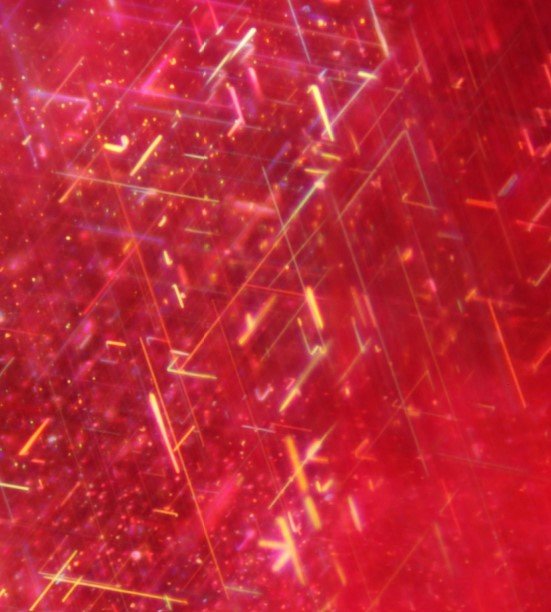
Fine rutile silk in ruby
How to spot treated ruby
The most common treatment is heat treating the natural ruby to even out the clarity and improve colour. This has long been an acceptable way to treat gems including rubies but must always be disclosed to the buyer. It can be spotted by the altered inclusions eg a halo or tension cracks around a natural inclusion where heat has caused an expansion around it. In 1900s, chromium-diffused rubies were an issue for the market, a form of heat and mineral treatment which deposited a surface layer of intense colour onto poorer quality rubies. Continuing on from this was beryllium diffusion of ruby often those from Tanzania, in the early 2000s which made a much prettier red from the brown and dark rubies. These treatments are spotted by examining the facet edges.
Lead glass infill has been used to fill drill holes since Medieval times and was a widespread problem in low quality rubies on the market from around early 2000s, and can be seen under magnification and good light.
Advanced analytical methods in addition to microscope examination include infra-red spectroscopy to detect alterations of sub microscopic particles caused by non-natural heat treatment.
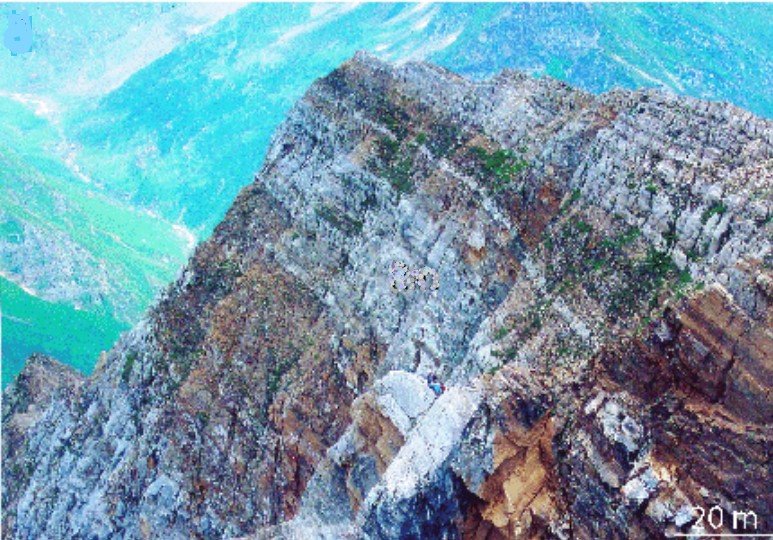
Ruby in metamorphosed carbonate platforms from Central and South-East Asia - the Nangimali formation, Pakistan, the ruby deposit is in the white marble. Photo (amended) after Gaston Giuliani
How are natural rubies formed?
It’s incredibly rare for all the specific conditions and ingredients to be present for rubies to form, especially in quantities we can mine economically in sizes we can use for jewellery. Ruby, the red form of corundum, is a rare crystalline mineral tending to form in tiny sizes either in a melted rock, or at the hot saturated contact points of two different ‘host’ rocks, deep under the Earth’s surface. Ruby forms during turbulent periods of high pressure and temperature, for example during the ages it takes for mountains to build, or continent margins to subduct, for continents to rift apart or volcanic provinces to form.
Read on if you like the technical science-y bit.
There are two main ways for rubies to form, firstly when a highly specific recipe of molten basalt rich in aluminium and oxygen, but low in silica and with trace levels of the rare earth metal chromium, cools at the right temperature, this might be just perfect for the ruby to crystalise inside the cooling melt.
The second way is the more frequently observed genesis. It occurs when scalding water percolated between two very specific rocks to saturate a thin reaction zone, where leached aluminium and oxygen can react with an unusually low amount of silicon in the other rock along with a trace of chromium, such that crystals of corundum can start to grow.
In this type of formation, the host rocks which formed the once saturated interface where rubies are found, vary widely and span the whole of Earth’s history: from relatively young layers of marble intercalated with gneiss and schist, eg in the rubies formed in the 45 million year old (and still on-going) Himalayan arc stretching from Vietnam, through Thailand and Burma and on through the Himalayas to Pakistan and Afghanistan; via 600 million year old mafic and ultramafic rocks and pegmatites (pockets of large crystals) in Kenya and the rest of the Pan-African gemstone belt stretching from East Africa, Madagascar, India & Sri Lanka; back to some of the oldest rocks on Earth - 3 billion year old Eton-mess of gabbros and ultramafic rocks, at Aappaluttoq in West Greenland.
Incidentally, rubies from Mogok, Myanmar were tested and found to have been formed 30 million years ago in a depth of around 10 kilometres below the surface of the Earth at temperatures ranging 550 to 700 degrees Celsius.




